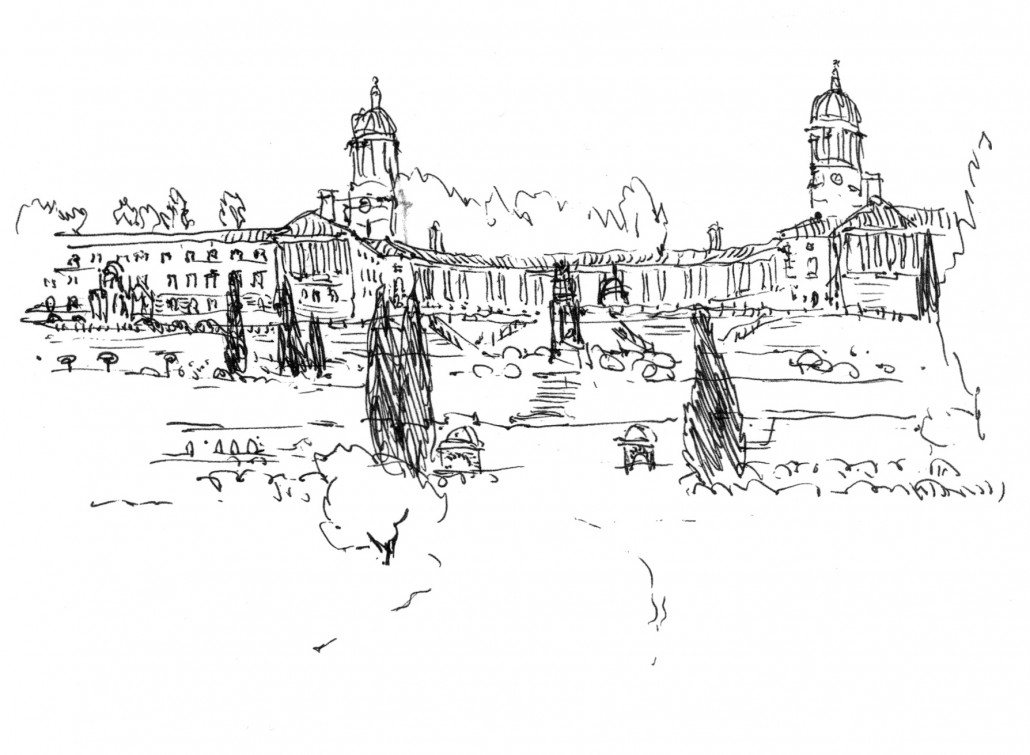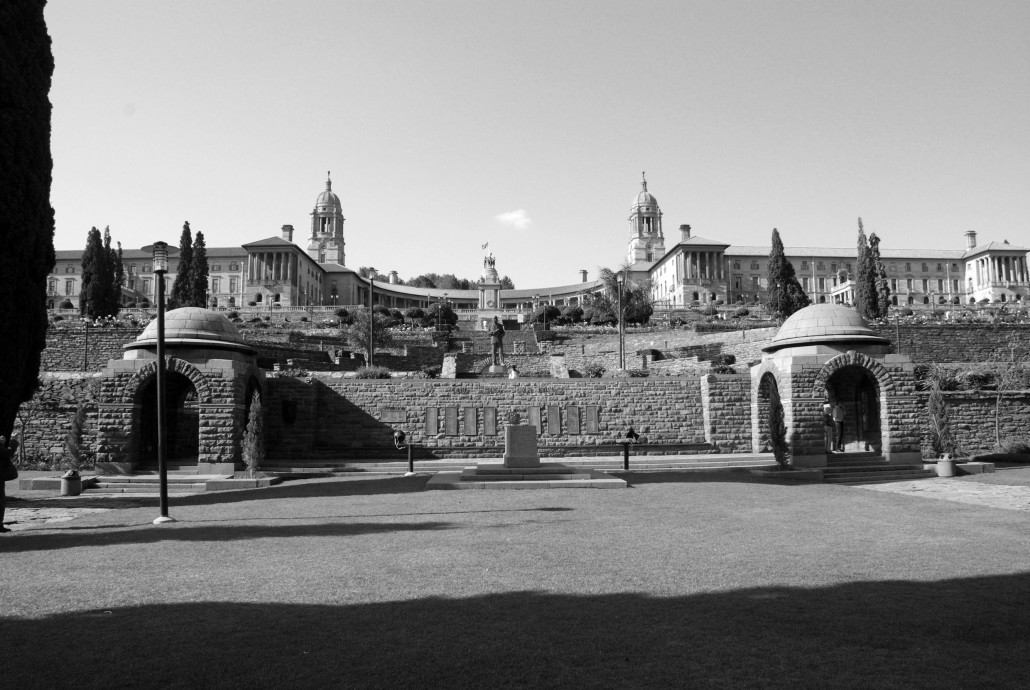The Union Building, Pretoria
by Richard Havelock
We had been eagerly anticipating the fourth day of the expedition when we were to contemplate this great monument to the settlement after the South African War of 1899-1902. As our mighty expedition bus, frequently provoking the bemused gaze of passers-by, headed towards our awaiting reception and lunch at the Presidential Guest House, we had our first glimpse of the Union Building set high on the layered terraces perched above the extensive park.
Marcus Holmes, an eminent local conservation architect, gave a provocative introductory talk before lunch, followed by a more detailed history on our arrival at the Union Building, which seems to be generally regarded as the masterpiece of the Baker office in South Africa, and amongst the finest and most impressive state buildings in the world. We sat on the stone seats around the open-air amphitheatre before the great semi-circular colonnade. Although there were only thirty-three of us, the amphitheatre was originally conceived as able to accommodate several thousand people, and also a small partly-open council place for Natives who, denied entry to the building as were we, could nevertheless, also like us, ‘feel the majesty of government’ from outside!
It may perhaps have been the relatively huge expense of Baker’s designs for the Presidential Guest House – between 1902 and 1906 the cost rose from £25,000 to £94,000 – that made the new South African Government so wary of expenditure on the Union Building. Although there were some official doubts about Baker’s initial design, and a committee was appointed to oversee the project, it was in due course completed within budget and the proposed time. Marcus’s view was that it was as a businessman and project manager that Baker excelled: this ability exceeded his architectural talent, and the quality of the Union Building was due to the fact that most of the details were designed by other members of his office staff.
However, there are also tantalising clues as to his relationship with Lutyens, which echoed subsequently in New Delhi. Baker saw original classical buildings on his Grand Tour of April to July 1900, instigated and paid for by Cecil Rhodes, and started to build in this style well before Lutyens. Baker’s design for the Union Building, including the siting and terracing, clearly reflects particular buildings and gardens that he had seen in Italy and Greece, and evidently owes something also to illustrations of ancient Hellenic temples in a book by Reginald Blomfield, The Mistress Art. As part of his tour of South Africa, Lutyens visited the construction site in December, 1910 and seems to have been impressed, his inspiration perhaps the germ of collaboration with Baker at New Delhi. Marcus even suggested that Baker may have been instrumental in Lutyens securing the commission there, although our own eminent Architectural Adviser, Mervyn Miller, demurred!
The Draft Act of Union of 1909 envisaged Cape Town, the old British capital, as the seat of Parliament, and Pretoria as the administrative centre – and it was for this purpose that the Union Building was needed. The last act of the former Transvaal Government was to vote its remaining funds, some £1.5 million, towards its construction.
Herbert Baker, then working on Pretoria Station, was approached. At his instigation, the site was shifted from the town centre to the dramatic hillside position used, selected with Jan Smuts. A sketch of the original design was sent to General Botha, the Prime Minister, in June 1909. It was essentially as built, consisting of the two main blocks, symbolising respectively the British and the Afrikaan components of the Union, linked by a central semi-circular colonnade, above the middle of which was placed a small cupola. On the strength of this scheme, Baker was appointed architect the following month, with the stipulation that the organisation and supervision of the work would be undertaken by the Public Works Department, under its redoubtable Secretary, Charles Murray, whom Baker described as a ‘hard-headed Aberdonian, combining the efficiency of an official and an engineer with the talents and imagination of a poet’ – presumably, therefore, a useful collaborator.
Afrikaan components of the Union, linked by a central semi-circular colonnade, above the middle of which was placed a small cupola. On the strength of this scheme, Baker was appointed architect the following month, with the stipulation that the organisation and supervision of the work would be undertaken by the Public Works Department, under its redoubtable Secretary, Charles Murray, whom Baker described as a ‘hard-headed Aberdonian, combining the efficiency of an official and an engineer with the talents and imagination of a poet’ – presumably, therefore, a useful collaborator.
There is fascinating speculation to be had about the contribution of Lutyens to the design. Baker sent him his preliminary drawings for comment, and there are handwritten comments and modifications by Lutyens raising the possibility that the twin domed towers (clearly in homage to Wren’s at The Royal Naval Hospital, Greenwich) that mark the junction between the two main blocks and the colonnade, may well have been his suggestion, deriving from his unsuccessful entry to the competition for County Hall, London in 1908. At the same time, however, an engraving of a painting by Turner of Wren’s building hung in Baker’s office. The same design, rotated through a right angle, was used later in his Secretariat buildings at New Delhi. Wren’s maxim that “architecture has its political uses that it builds a nation” would have struck a chord with the ambitions of Baker, who told Murray, quoting Wren, that the administrative offices of a nation should show “the attributes of Law and Order, which are themselves eternal”. Lutyens also suggested a less direct, and more decorative, path of ascent to the building.
The long line of the exterior facing down over the park is broken in front of each of the original Ministers’ rooms by a projecting portico, one at each end of the two main blocks, so making four in all, together spanning the whole façade. Using a Palladian technique, the middle of each portico is emphasised by gradually diminishing the width of the gaps from the centre towards each side. This is echoed by the grouping of the columns of the central colonnade itself, single at the outer ends, then doubled, and finally tripled to give weight to the middle. Perhaps it is this emphasis, consolidating the weight of the colonnade as a whole that, like the Queen’s House at Greenwich, actually overcomes the “unresolved duality” that some have considered results from the two domed towers. The four porticos may have been intended to represent the four antecedent states, the Cape Colony, Natal, the Orange Free State and the Transvaal.
By October 1909, only three months after Baker’s appointment, the Government’s doubts about the position and cost of the proposed building led to the setting up of an Advisory Board. Baker argued that the south-facing aspect of the building would keep it as cool as possible, but his positioning of it was then criticised because it would also, through being in shade for most of the day, appear as a ‘dark, uninteresting square mass’. His critics took issue also with the ‘extravagant and expensive scale of the colonnade’, and furthermore whether the amphitheatre, with its tiers of bare stone steps, open to the weather, would ever be used. In fact, long before accommodating our party, it quickly became an arena for important national occasions, from early military victories to the induction of Nelson Mandela as President.
The criticisms were published in a report which, although supposedly confidential, came to the attention of Baker who then, as the skilled committee man that Lutyens recognised him to be, wrote a vigorous riposte. Whilst conceding a few modifications of detail, he successfully defended the essence of the scheme, including the need for some embellishment and the practical benefit of the colonnade in providing a covered passage to connect the two side blocks. Later he acknowledged the decisive support of this by Generals Smuts and Botha, who no doubt appreciated as soldiers and statesmen the virtues of climatic protection as well as pomp.
Because it was considered that no single contractor would be able to afford to undertake the complete project, it was divided between three separate tenders, one for each of the main (side) blocks, and a third for the colonnade. In the event, one firm built both of the main blocks (for £622,500 altogether) and another the colonnade (for £256,224). The fact that there was no love lost between the two enabled the Public Works Department to minimise the costs by playing one off against the other whenever the opportunity arose. Murray, its Secretary, declared after completion in 1913 that it was ‘pretty well a record for a building costing £958,000 to be finished within Estimate and without a Law-suit’. There were a number of remarkable features. Although one of the contractors was a pioneer of reinforced concrete in Cape Town, the scale of the project was unprecedented in South Africa. It entailed the first use of a tower crane in the country – at one time over 90 cranes were in use simultaneously. 768 skilled artisans were employed from countries as varied as Alaska, Germany, Belgium, France, Great Britain and Australia, presumably as well as an army of labourers. Not the least impressive aspect was the outstanding safety record for that time, in that there was only one fatal accident, and only a small number of minor ones.
In modern projects of this kind the contribution of the individual architect, as one of a number of members of a multidisciplinary partnership, tends to be less discernable than in the simpler days of the past. Perhaps this is another progressive characteristic of the construction of the Union Building, although it seems that Baker was not forward in giving credit to other contributors.
Because of perceived shortcomings in the original creamy white sandstone used to construct the main part of the building, above a plinth of granite, increased costs were incurred which precluded the commissioning of the statues originally intended to grace the various plinths around the amphitheatre, which therefore remain empty, perhaps looking to Trafalgar Square for inspiration! Charles Murray was keen for there to be a statue of ‘Edward VII as Peacemaker’, and tried to persuade Lady Phillips, wife of Sir Lionel, the ‘Randlord’, and benefactress of the Johannesburg Art Gallery, to ‘leave pictures for a bit and persuade some of her millionaire friends to donate this statue. She promised to do her best, but unfortunately there were not so many millionaires about as there used to be’. There is, however, above the cupola at the centre of the amphitheatre an elegant bronze figure of Mercury by Derwent Wood, later Henry Moore’s teacher.
And what of the legacy? The generally healthy state of the building today is testimony to the quality of its construction and materials, including the stone and the teak woodwork. It is clear that Baker understood the challenge of building on a hill, and he may have interpreted perspective drawings better than Lutyens, which raises interesting questions about Raisina Hill in New Delhi – were the seeds of Lutyens’s Bakerloo sown in Pretoria?
We re-embarked into our coach at the foot of the park, and enjoyed our final view of the splendour of the Union Building bathed in the mellow late-afternoon sunlight, a striking memorial to all those who conceived and created it, whether credited or not.
Richard Havelock




